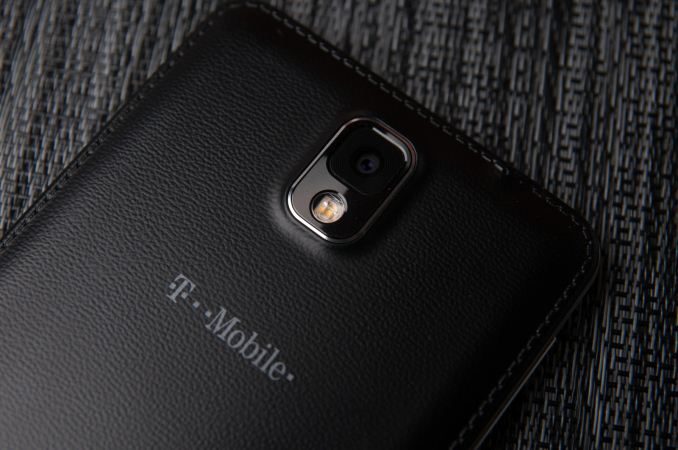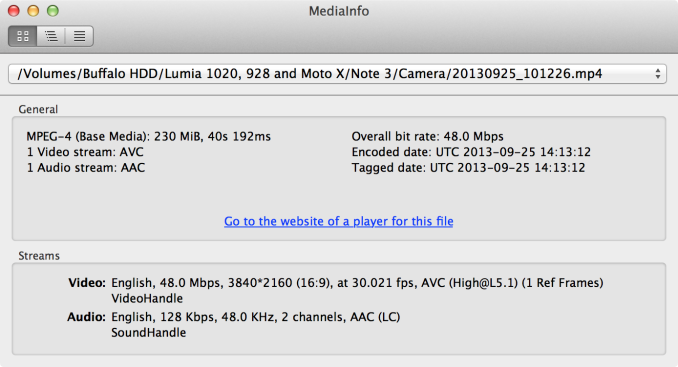Samsung Galaxy Note 3 Review
by Brian Klug on October 1, 2013 9:00 AM EST- Posted in
- Smartphones
- Samsung
- Mobile
- Android 4.3
- galaxy note 3
Camera
The cadence for camera on the Note platform has been pretty steady so far, it just inherits the camera module from the Galaxy S that came before it. In the case of the Note 3, that means the same module from Galaxy S 4, which is as far as I can tell what happened here. There’s an IMX135 sensor inside the Note 3, same as what shipped in GT-I9500, from Sony’s Exmor RS line. Specifically that means the Note 3 includes a 13 MP CMOS on the back with 1.12µm size pixels and a 1/3.06" optical format. Focal length changes slightly from 4.2 to 4.1 mm, but I’m not sure if this is just a rounding error, I suspect the same optical system is shared between the two, this works out to 31mm of focal length if you’re thinking 35mm equivalent numbers.
On the front is a 2 MP Samsung S5K6B2 CMOS with 1.34µm and 1/6" format. This is also shared with Galaxy S 4, which isn’t too surprising. So we have the same imaging on the back and the front as that flagship, with just different ISP in front of it with 8974.
Stills
For image quality we turn to the normal set of tests which I seem to always be adding to. Image quality bench locations taken at our usual set of locations, 3, 4, 5, 6, and 7 with the Note 3. In addition lights on and lights off in the lightbox, and the usual set of test targets.
Gallery: Smartphone Camera Bench
The Note 3 looks good outside and obviously reminds me exactly of the Galaxy S 4 when it comes to imaging performance. I never really had issues with SGS4 outside or in well lit scenarios, the Note 3 ends up being just about the same. I can’t say there’s really any surprises when it comes to still images out of the device, although the Note 3 absolutely struggles with white balance in the lightbox for some reason, which is odd considering Galaxy S 4 definitely didn’t have similar problems. Anyhow if you liked SGS4 imaging performance, Note 3 is definitely the same, it doesn’t really change the formula in low light however against the competition that now has OIS and bigger pixels, but I won’t belabor that point again.
Video
On the video side of the Note 3 we have an interesting new addition, 4k30 (or UHD) video record support, alongside both 1080p60 and 720p120. Higher framerate video has been an increasingly common thing lately, and the Note 3 supports this with the new video encode and decode capabilities of the 8974 SoC (Exynos 5420 doesn’t get any UHD video record features).
In the video recording UI you can select between the above video resolutions, at a framerate of 30 FPS. To get to 1080p60 you have to go under a different menu and select smooth motion, and 720p120 is under slow motion.
4k30 video gets recorded at 48 Mbps H.264 high profile with 1 reference frame, which will eat up space quickly but obviously blows things away with that much resolution, and 8974 doesn’t drop frames either. The 1080p60 video comes in at 28 Mbps H.264 high profile and also doesn’t seem to have any dropped frames. Audio in both cases is 128 kbps 48 kHz stereo AAC.
I uploaded two UHD samples to YouTube since it’s already 4K aware, if you select original quality from the switcher drop down. I don’t have a 4K display to view these on, but oversampled on the high resolution panels I do have it looks amazing. The 1080p60 content also looks great, although you’ll have to grab that one and view it on your own since YouTube (and really nowhere online I’m aware of) will show you 60p video at native framerate. I shot UHDp30 and 1080p30 videos in Times Square in NYC which you can grab, and UHDp30 and 1080p60 videos at the bench location which you can also grab if you want to look at that buttery smooth 60 FPS video.
I’m really impressed with video quality coming out of the Note 3, obviously having smartphones coming with UHD onboard is a big treat, and we now have smartphones beating other bigger standalone cameras to that punch.






















































302 Comments
View All Comments
cdomigan - Tuesday, October 1, 2013 - link
Extremely disappointed in AnandTech for their passive stance on benchmark cheating. Please live up to the high expectations you have set for tech journalism and call this out for what it is!Wade_Jensen - Tuesday, October 1, 2013 - link
I would've liked a bit more depth on subjective UX in terms of responsiveness and lag/stuttering. I'm sorry, but I'm starting to think that Touchwiz is just so inefficient and poorly coded that galaxy devices lag no matter how much ram and compute you throw at them.After all S600 was seen as crazy fast at the start of this year but at the end of the day the GS4 still feels slow and heavy for basic operations compared to any other ROM (except motoblur haha).
tanyet - Tuesday, October 1, 2013 - link
I agree with this wholeheartedly. Touch responsiveness and a lag free experience is what I want most in mobile devices. I can say that I haven't noticed any lag or "micro stutters" with my Note 3 and I'm really obsessed with these things. It's still not as smooth as iOS but I feel that's more to do with Android than Samsung. It took me awhile to get used to not having the bounce back effect and it also took awhile to get used to the speed of scrolling (or the abruptness of the scroll stopping) I chalk this up to patent issues. Mine definitely doesn't display the choppiness I've seen with some friends S4's. Who know though. It's early days.I would really love the TouchMarks benchmark to be added to the list of reviewer tools because I feel that it is a much better gauge of user experience than some others.
Dentons - Tuesday, October 1, 2013 - link
Come on Brian. We know you don't care about two of Samsung phone's biggest selling points, user replaceable batteries and MicroSd expansion, but not giving those real, actual features any appreciation or credit at all? That's a bit much.Unlike Brian, some of us really, really, really care that Samsung allows us to carry extra batteries and store our ever growing media libraries on MIcroSD. We know you don't care. You dismiss those features in nearly every Anandtech Podcast, but should your personal use habits so prominently factor into a review this comprehensive?
Apple doesn't have these features.
Google Nexus doesn't have these features.
HTC don't have these features.
It's a major differentiator. For many of us, it's a big deal, perhaps one of the primary reasons many will buy this phone over its competitors.
ScorpionRaY - Tuesday, October 1, 2013 - link
Agree!nerd1 - Wednesday, October 2, 2013 - link
Totally agree. Nowadays micro SD memories are dirt cheap and apple is still charging $100 for extra 16GB...Davidjan - Thursday, October 3, 2013 - link
Agree with you. Meanwhile we can use this Meenova MicroSD reader to add storage: http://goo.gl/U6IyYSpunjji - Tuesday, October 8, 2013 - link
Entirely agreed. I'd have happily bought a Nexus 4 for a lot less money were it not utterly impossible to store my (modest!) media collection and photos downloaded from my camera on there.Similarly I refuse to pay Apple ~£160 extra just to get slightly less capacity with their flagship phone than I got for my Note 2 by paying £40 for a 64GB MicroSD card. Were it not for this option I would have to submit to the blatant scam that is NAND upgrade pricing.
tuxRoller - Tuesday, October 1, 2013 - link
Whoa, what's going on with the G2 in the 4G tests? It was far and away the best at 3G and I thought the current AT reasoning was that 4G only improved the browsing time over 3G by racing to idle? Is the Qualcomm 4G baseband that bad?ithinkux - Tuesday, October 1, 2013 - link
To me, the benchmarks presented above prove, beyond any doubt, that Apple did the right thing switching to 64-bit architecture.